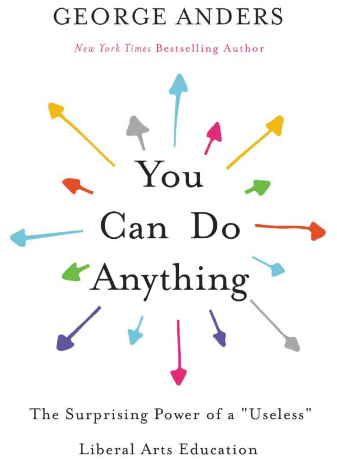![]()
New York Times bestselling author, George Anders, knows the value of a liberal arts degree firsthand. In his latest book, You Can Do Anything: The Surprising Power of a “Useless” Liberal Arts Education, Anders highlights how a degree in the arts opens countless doors for graduates. “A liberal arts degree provides enormous flexibility, and in times of rapid economic change, that can be a tremendous boon,” the author tells LiberalArtsColleges.com. As Anders wrote in his book, “when you collect your diploma, you don’t yet know what kinds of jobs you do best, what type of work satisfies you the most, or where the best career opportunities reside.”
One compelling story in Anders’ book is that of Peggy Washburn—an Oberlin College graduate with a B.A. in law and society. The author explains that Washburn was one of the happiest people he met during his research. Her resume is also quite impressive. “[She] has worked in fields ranging from newspapering to nonprofit fundraising, television production, public relations and independent filmmaking,” Anders notes. “Now she’s a digital producer for the Denver Post.”
 It’s no surprise that Washburn—and other liberal arts students—are open to exploring various career paths. “According to the Bureau of Labor Statistics, the typical college graduate works in 5.8 different jobs between ages 22 and 28,” Anders tells LiberalArtsColleges.com. “That amounts to significantly more experimenting than people with associate’s degrees or high-school educations pursue.”
It’s no surprise that Washburn—and other liberal arts students—are open to exploring various career paths. “According to the Bureau of Labor Statistics, the typical college graduate works in 5.8 different jobs between ages 22 and 28,” Anders tells LiberalArtsColleges.com. “That amounts to significantly more experimenting than people with associate’s degrees or high-school educations pursue.”
He adds, “It turns out that the great advantage of a college degree isn’t long-term stability; it’s flexibility. A liberal arts background is particularly good at developing the analytical, problem-solving and communications skills that can come in handy in all sorts of jobs.”
In an article for Forbes, Anders—a contributing editor for the popular website—shared the inspiring story of Slack Technologies cofounder and CEO, Stewart Butterfield. Following his undergraduate program at Canada’s University of Victoria, the successful businessman earned master’s degrees in philosophy and the history of science from Cambridge.
“Studying philosophy taught me two things,” Butterfield told Anders. “I learned how to write really clearly, [and] I learned how to follow an argument all the way down, which is invaluable in running meetings.”
Butterfield’s history of science courses had a similar impact. “I learned about the ways that everyone believes something is true,” he said, following up with an example: “Like the old notion of some kind of ether in the air propagating gravitational forces–until they realized that it wasn’t true.”
Washburn and Butterfield’s success stories are just two examples. The appreciation of a liberal arts education is ever-growing, but Anders acknowledges that individual results may vary for new graduates applying for jobs. “Reactions vary enormously,” he notes regarding employers. “In technical fields, obviously, the appropriate technical skills are most in demand. Lockheed Martin needs aerospace engineers, rather than people with a poetic appreciation of flight. But even tech-minded companies like Google or Facebook have a surprisingly large number of openings that are liberal arts-friendly in fields such as marketing, sales, human resources and law.”

Many college students dream of landing the perfect high-paying job. Feeling fulfilled in a position, however, should also be a priority. “Some of the hallmarks of a liberal arts education—being well-read, taking an interest in other cultures, being curious about many things—may translate into at least a slightly better chance of long-term fulfillment in or out of work.”
Anders’ praise of a liberal arts education shouldn’t be mistaken as bias. The Stanford graduate addresses those students struggling to choose between a liberal arts college and a school with a stronger pre-professional focus. “There’s honor in both paths,” he says. “Within my own community, I’ve seen one high school graduate head off to the Air Force Academy because he knew he wanted to be a pilot, while another student opted for a renowned liberal arts college because she wasn’t sure whether she wanted to be an actress or a biochemist. Good for both of them! One of America’s great strengths is the vast diversity of college choices that are available to high school graduates. For many students, the choice makes itself.”
Even those students who opt for a more traditional program should keep an open mind when choosing courses, according to Anders. “I’d urge even the students with the keenest pre-professional interests to make time for a few landmark classes in literature, philosophy, psychology or other fields,” he encourages. “We shouldn’t think of college as just a trade school; it’s a chance to widen one’s intellectual horizons, and to embrace unexpected new forms of knowledge.”
This compilation of knowledge has a long-lasting effect. Anders concludes, “As a look at the way people’s careers unfold in their 30s, 40s and 50s, it’s striking how many of the best opportunities are seized by people who go through life with at least a little of the liberal arts enthusiast’s spirit of exploration.”
